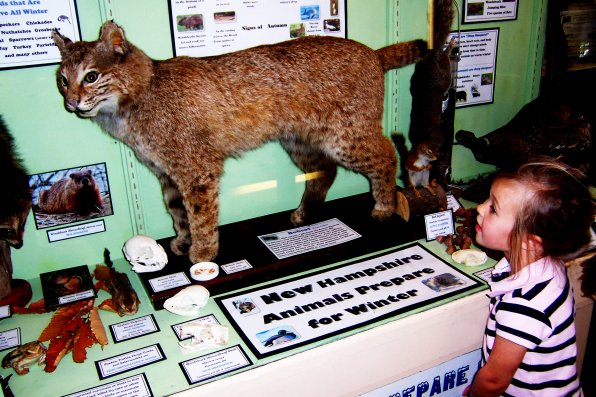“Can a wild bobcat mate with a domestic house cat?” she asked, her face reflecting the earnest inquisitiveness of her voice. I was volunteering at the Little Nature Museum in Contoocook when a woman came in with that question.
“Why do you ask?” I responded. “Well,” she said, “in our Concord neighborhood, there is a large cat that appears to be half bobcat and half housecat,” her voice shifting to a “stranger things have happened” mode.
“Do you have a photo of it?” I inquired. “No, every time I see it I do not have a camera, but I will keep trying to get a photo,” she declared. She then described the feline critter as having the spotted markings of a bobcat and large hind legs.
Taking a quick glance around the museum, she said, “I want to see your mounted bobcat to help me decide if indeed the animal I have seen could possibly be the offspring of a union between a bobcat and a house cat.”
We went to the large glass case displaying a mounted bobcat. Standing there looking at the bobcat, she said, “The cat I am talking about has some of the physical features of this bobcat, is very secretive and has the behavior of a wild animal. None of my neighbors claims the cat.”
We talked further about her sightings of this mysterious “bobcat/house cat” creature. As we concluded our conversation, she emphatically announced, “I must get a photo of that cat.”
In Lives of Game Animals, author Ernest Thompson Seton described the bobcat as being a “spitfire demon with a perennial growl and a physiognomy distorted with diabolic rage when approached.” He further wrote that the bobcat is in such “perpetual ill-humor that the name wild-cat has become a synonym of fighting ferocity.”
There was a bounty on bobcats in New Hampshire from 1809 to 1973. The bounty was occasionally repealed and then reinstated. Hunters got $3 per bobcat from 1809 to 1828. Eventually the bounty reached $20 from 1929 to 1960. The harvest peaked in 1959 with 421 bobcats killed. From 1989 to the present there has been a closed season on bobcats.
I contacted Dr. John Litvaitis, Professor of Wildlife Ecology in the Department of Natural Resources and the Environment at UNH. I asked him if a bobcat could mate with a house cat. He replied that he had heard stories about such creature but had never seen any concrete evidence.
For now, we must be content with listening to the stories and deciding for ourselves if some of the house cats roving the countryside might possess a few bobcat genes.










May 9, 2018
I was a cashier in the tiny town we live in, when a lady came in crying that her husband wanted to kill her cat’s only kitten because they could not afford to keep it. (Note here, every single person in our town knows what a bleeding heart I have…) So, if course, I offered to take the cat. He was absolutely gorgeous, loving, a little big for his age but it didn’t warrant any special attention in my mind. About a week later, she came back into the store and asked how I liked him. I told her how he was fitting right in and how much we already loved him. With great relief, she said, “Great!! So can I tell you why I REALLY had to get rid of him…??” Which took me back but of course I had to know. She explained that she has a bobcat lynx hybrid, who has never been mated because of her size and violent tendencies. But a very large cat, that she believed to be a wild tomcat buy wasn’t sure, tagged her girl and she had the 1 and only baby. Which, at the size they can get to, she and her husband could not afford to take on. I wish I had known then, I would have named him “Simba” instead of “Garfield”. The older and bigger he is getting, the more his breeding is obvious. He, in turn, mated with our domestic house cat, and the kittens look more lynx than he does himself!!